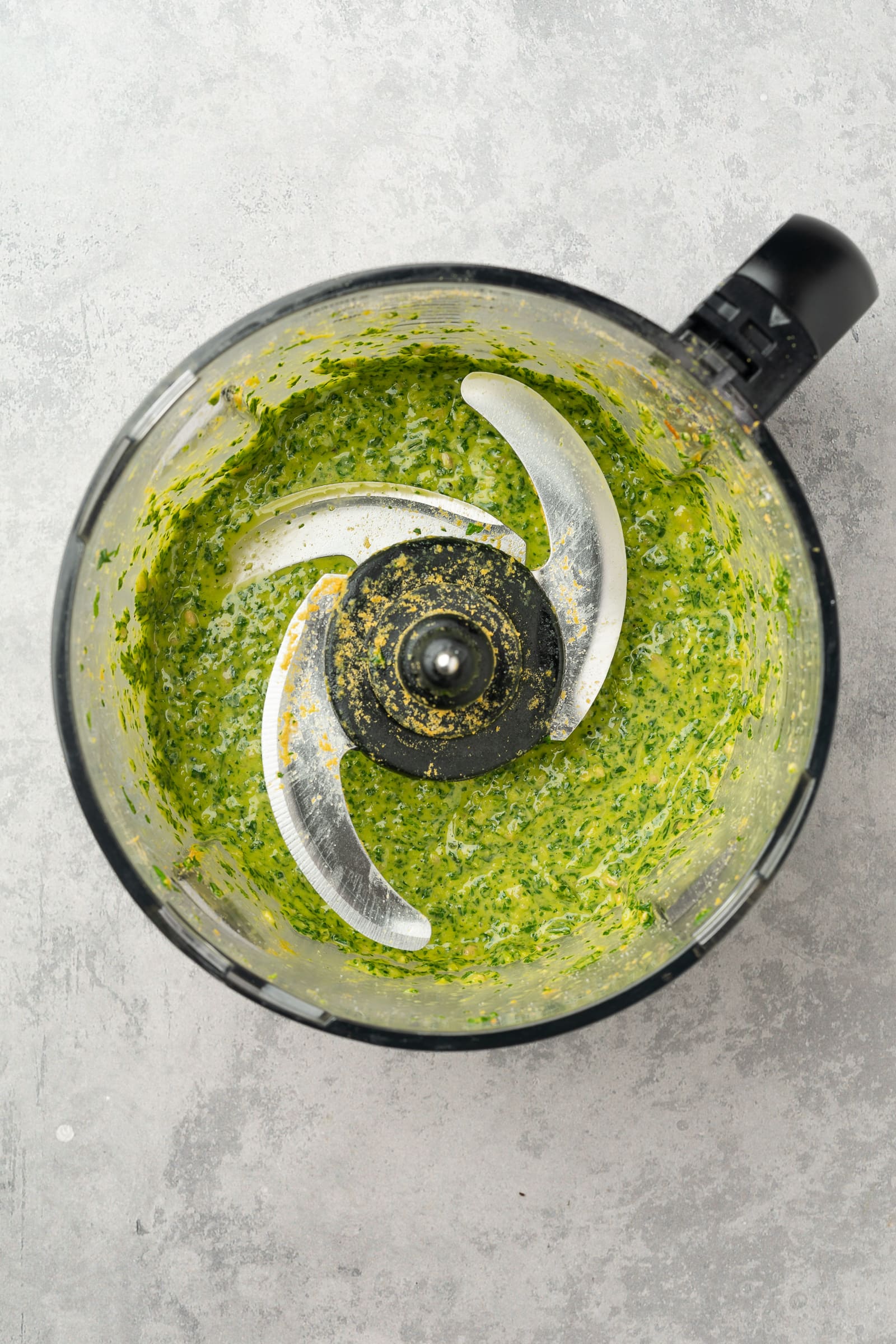This Nut-Free Vegan Pesto comes together in just 10 minutes and is packed with fresh and vibrant flavors that pair perfectly with pasta, pizza, sandwiches, salads, grain bowls, and more.

Jump to:
This nut-free pesto is a delicious alternative that maintains the vibrant flavors of traditional pesto without the addition of nuts. Instead, it uses roasted sunflower seeds!
I absolutely love pesto and thankfully it's incredibly easy to make vegan.
This versatile sauce is nut-free, dairy-free, gluten-free, and delicious!
Ingredients
Having a go-to recipe is always handy, and this simple vegan basil pesto is one that deserves a permanent place in your repertoire.
It's particularly perfect during the summer season when fresh basil is abundant, ensuring a burst of vibrant flavors in every bite.

Basil: Basil is a traditional part of pesto. Always use fresh basil, rinse, and pat dry before adding to the food processor to ensure a beautiful bright green color.
Spinach: I love adding half basil and half spinach. I sometimes switch out the spinach will arugula or parsley depending on the flavor I'm going for.
Sunflower Seeds: This is a nut-free pesto recipe so we have swapped pine nuts for sunflower seeds. Sunflower seeds will add a savory flavor and make the pesto creamy and adds a nutty flavor despite being a nut-free recipe. I recommend roasted and unsalted sunflower seeds.
Nutritional Yeast: A key ingredient to traditional pesto is Parmesan cheese but we will be using nutritional yeast to make it vegan. You could also use a vegan parm if desired.
Lemon Juice: Fresh lemon juice is added to brighten up the pesto and add a bit of acidity and extra flavor. It's not a mandatory ingredient but balances out the flavors and is highly recommended- but don't add too much or it will overpower the pesto.
Garlic: Minced garlic cloves add a nice flavor to pesto but if you didn't want to add raw garlic, try out garlic-infused olive oil. I often use that instead and it's lovely!
Seasoning: Kosher salt and black pepper are all the seasonings you will need for this homemade vegan pesto recipe. Red pepper flakes would be a great addition as well.
Extra-Virgin Olive Oil: I highly recommend using good quality extra-virgin olive oil. The flavor really comes through and creates a smooth pesto. I don't recommend any other oil.
Helpful Equipment
A food processor or blender comes in handy when making homemade pesto.
I use and recommend a Ninja food processor.
Pesto is best when the olive oil is slowly incorporated while being processed. To achieve this, a food processor with an opening is preferred.
How to Make This Recipe
This vegan version of pesto is simple to whip up and made without dairy or nuts!
The full recipe is detailed in the recipe card below.

Step 1: Add the fresh basil, spinach, sunflower seeds, nutritional yeast, lemon juice, garlic cloves, and salt into a food processor.

Step 2: Close the lid and begin to process until coarsely ground.

Step 3: Then, use the opening in the food processor and slowly pour in the olive oil until you have added the full ½ cup.

Step 4: Taste and add additional salt and black pepper if desired. Pulse for a few more seconds to combine and enjoy!
Substitutions & Additions
Feel free to change things up depending on what you have on hand or go wild with your favorite flavors!
Spinach: Leave out the spinach and replace it with kale, arugula, or more basil.
Sunflower Seeds: Pumpkin seeds or hemp seeds will work as well. If you don't want this to be nut-free, you can use cashews, pinenuts, or walnuts.
Nutritional Yeast: Vegan Parmesan cheese will work just as well. Violife and Follow Your Heart are my go-to brands.
Garlic: If you don't want to add raw garlic, feel free to roast it or use garlic-infused olive oil instead.
Extra-Virgin Olive Oil: I don't recommend using anything other than extra-virgin olive oil because it adds the best flavor.
Add-Ins: Roasted Red Peppers and Sun-Dried Tomatoes are my favorite things to add! But red pepper flakes and lemon zest are great too!

Serving Ideas
Pesto is commonly used as a pasta sauce but there are many other delicious ways to incorporate pesto into your meals.
Pasta: Toss cooked hot pasta with pesto sauce for a simple and classic dish. Change it up by adding roasted veggies and white beans as I did in this recipe for Vegan Pesto Pasta with Veggies.
Sandwiches and Wraps: Spread pesto on sandwiches or wraps. It pairs well with roasted vegetables like eggplant, zucchini, and red bell peppers.
Pizza: Use this fresh basil pesto as a base sauce for homemade pizza. Top with your favorite ingredients like roasted tomatoes, vegan mozzarella, olives, and fresh basil.
Roasted Vegetables: Drizzle pesto over roasted vegetables such as potatoes, carrots, zucchini, or cauliflower. It adds a burst of flavor and turns plain veggies into a delicious side dish.
Bruschetta: Top toasted baguette slices with pesto, cherry tomatoes, and a sprinkle of vegan Parmesan cheese.
Tofu Scramble and Omelettes: Add a dollop of pesto to a tofu scramble or incorporate it into Just Egg omelets for an extra burst of flavor.
Grain Bowls: Use pesto as a dressing for grain bowls, combining it with cooked grains like quinoa or couscous, along with roasted vegetables and chickpeas.

Tips & Tricks
Let's talk about salt! Not all salts are equal and cannot be substituted 1:1. If you opt for table salt instead of kosher salt, you will want to cut the amount called for in the recipe by at least half.
Use fresh ingredients: The flavor of pesto relies heavily on the freshness of the ingredients. Choose fresh basil leaves and high-quality extra virgin olive oil for the best results.
Use roasted sunflower seeds: Buy roasted sunflower seeds or toast the seeds lightly in a dry pan over medium heat until they become slightly golden.
Adjust the texture: Pesto can have a smooth or slightly chunky texture depending on personal preference. If you prefer a smoother consistency, blend the ingredients for longer. For a chunkier texture, pulse the ingredients a few times to maintain some texture.
Customize: You can substitute the spinach and basil with other fresh herbs like cilantro, parsley, or even arugula. You can also try different nuts or seeds to change it up!

Storage
Storage: Leftover pesto should be used within 3-5 days. Note that the top of the pesto turns brown when stored because it is exposed to air but this can be prevented by adding some extra olive oil over the top or placing plastic wrap directly on the top of the pesto. Always store in an airtight container.
Freezing Instructions: I recommend freezing them in an ice cube tray, popping them out, and adding them directly to the pan with your pasta or vegetables.
Frequently Asked Questions
Traditional basil pesto has parmesan cheese in it but can easily be substituted with vegan parmesan or nutritional yeast and trust me when I say that the cheese won't be missed.
You don't need pine nuts to make homemade pesto. You can use sunflower seeds like I did in this recipe or walnuts, cashews, or almonds.
I prefer using nutritional yeast but vegan parmesan will work as well!
The top of the pesto turns brown when stored because it is exposed to air but this can be prevented by adding some extra olive oil over the top or placing plastic wrap directly on the top of the pesto. Homemade pesto should be used within 3-5 days.
Most likely, no but some are accidentally vegan. Trader Joe's has a delicious pesto but it is not nut-free.
More Recipes You'll Love
Please leave a 5-star rating in the recipe card below or leave a review in the comments section. Subscribe to my newsletter and follow along on Instagram for more recipes and updates.
Recipe

Nut-Free Vegan Pesto
Ingredients
- 2 cups Fresh Basil packed
- 2 cups Spinach packed
- ⅓ cup Sunflower Seeds roasted
- ¼ cup Nutritional Yeast
- 1 tablespoon Lemon Juice
- 2 Garlic Cloves minced
- ½ teaspoon Kosher Salt see note
- Pinch of Black Pepper
- ½ cup Extra-Virgin Olive Oil more if needed
Instructions
- Add the fresh basil, spinach, sunflower seeds, nutritional yeast, lemon juice, garlic cloves, and salt into a food processor. Don't add too much lemon juice or it will be overpowering.
- Close the lid and begin to process until coarsely ground.
- Then, use the opening in the food processor and slowly pour in the olive oil until you have added the full ½ cup or until you reach your desired consistency.
- Taste and season with extra salt and black pepper if desired. Pulse for a few more seconds to combine and enjoy!
Notes
Disclosure: This page contains some affiliate links. Please know that I may receive a percentage or commission from a link included on this page, at no extra cost to you. I will only ever recommend a product I have used and believe has substantial value to my readers.









Comments
No Comments